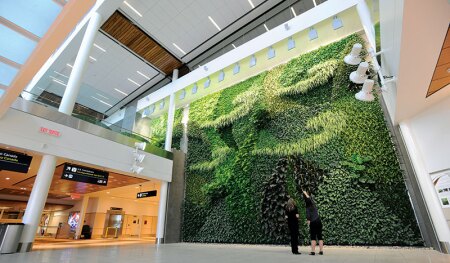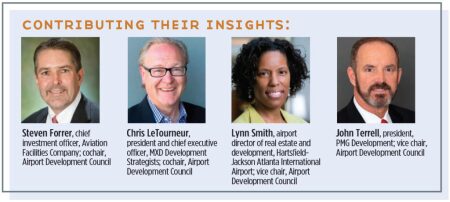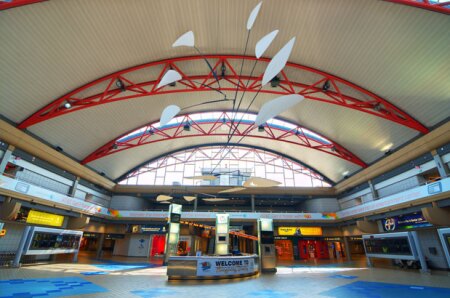What is coming for travel services, concessions, commercial development, and logistics?
Members of ULI’s Airport Development Council discuss the effects of the COVID-19 pandemic on airport development, the implications for funding airport development, design trends in passenger facilities, ways to strengthen the connections between airports and surrounding communities, and other trends.
If you are interested in applying to become a member of an Americas Product Council, visit Navigator to learn more or submit your statement of interest.
How has the COVID-19 pandemic affected development in and around airports, and how is the industry responding?
John Terrell: The aviation industry was hit extremely hard. Prior to COVID-19, there were three main non-aviation revenues at airports: concessions, parking, and commercial development. Two of these are passenger dependent. Commercial development generally involves long-term lease agreements, which have provided a continuing revenue stream through the pandemic, so airports are placing more focus on it now.
Lynn Smith: Overall, there have been slight adjustments in schedule and deliverables, but development is continuing at airports. At Hartsfield-Jackson Atlanta International Airport, our planning and development department is very busy. There has been increased development on the logistics side, but we are still moving forward with in-terminal development as well.
Steven Forrer: Although domestic leisure travel is now bouncing back, international passenger travel has been hard hit. Air cargo has been steady to growing overall, especially e-commerce, to the benefit of local communities and the airports they host, but the loss of international passenger travel has been and remains a material issue for international cargo that often flies with passengers. Many airports are doubling down on serving the air cargo and logistics industry to speed their recovery and provide post-pandemic incremental income. They likely will recover more quickly than those that are waiting for the passenger sector, particularly the international business traveler, to return. Beyond cargo, retail sales at most airports have ground to a near halt. One unintended consequence of airports focusing on hiring local vendors to operate shops and restaurants, which was beneficial to providing local jobs and providing a local flavor to the passenger experience, is that small local businesses often don’t have the financial resources to survive. Most airports have been thoughtful about helping local entrepreneurs where they can, but it still has been painful for many.
Chris LeTourneur: Airports have been severely impacted by the COVID-19 pandemic. In the first months of the pandemic, passenger movements declined by as much as 90 percent, with airport revenues dropping equally. However, airports that had already proactively planned their lands for commercial and industrial development, including logistics, have done quite well. E-commerce growth has skyrocketed. Some say that eight years of projected e-commerce growth has occurred in eight months. Cargo integrators including Amazon, FedEx, and UPS are the arteries that facilitate e-commerce fulfillment, transporting goods that arrive in containers by ships and rail [and] then are dispersed by air and ground for regional distribution by trucks. Airports are at the nexus of this supply chain. At the same time, health care and bio-life science logistics, personal protective equipment and vaccine deployment, and perishable food distribution have further driven demand for warehouse and logistics development. Airports have embraced this boom in logistics as a means for repositioning and diversifying their revenues through the strategic development of their properties.
What trends do you see in the funding of airport development?
Forrer: The private sector has a boatload of capital to invest in airports. COVID-19 has highlighted the fact that private-sector investors and developers can make a meaningful difference at airports, whether in cargo, retail, or terminal development. The federal government’s ongoing proposed infrastructure bills should have some funds for airports, but they likely won’t result in the funding levels that will be required for their full recovery, so we see private investment in airports continuing to grow due to the pandemic.
LeTourneur: A number of years ago, airports had to become financially self-sufficient and operated by local cities, counties, or airport authorities. This responsibility involves generating revenues to offset operating costs. This is why airports have taken an interest in commercial development, including retail, hotels, convention centers, offices, entertainment centers, logistics, advanced manufacturing, and technological innovation. Because the traditional primary role of airports is to move passengers and cargo, most airports have not been experts in developing land. Airport land development is further challenged by federal aviation restrictions and the fact that airport lands are typically developed by way of land lease tenure. As result, progressive airports are engaging development professionals and investment/operating partners to optimize and position their properties for commercial development.
Smith: During the pandemic, many of the airports have received financial assistance from different levels of government. In some cases, this was accompanied by requirements for more sustainable operations. We have been very conscious about spending. In addition, we have issued a number of requests for proposals for development related to air cargo. We have built new partnerships with cargo companies and freight forwarders.
Terrell: Before COVID-19, there was a significant lack of space and gates at airports, but after passenger traffic dropped, many of the capital programs for expansions of terminals and construction of new terminals were put on hold. Typically, an economic downturn such as this one is a good time to build capital programs and facilities, but in this case, even as passenger traffic fell, there was no corresponding drop in the cost of materials and labor. On the contrary, those costs went up. Airports will need to figure out how to fund capital programs, and many of them are turning to public/private partnerships.
How is the design of aviation facilities evolving to address the needs of 21st-century travelers?
Smith: We are incorporating technology like self-check-in kiosks, facial recognition, and innovative signage to help make arrival and check-in and boarding faster and less stressful, but we also rely on our people to help guide people and facilitate the process for passengers. As soon as you park in the parking lot or get dropped off at the curb, we have greeters to welcome you. Some airports are making flying more attractive by adding experiential entertainment, such as museums, art displays, and music. I am in constant communication with Pieter van der Horst, project director of Schiphol Area Development Company and managing director of Airport City Academy in Amsterdam, who pointed out that a lot of airports outside the United States are adding different kinds of quiet rooms. In Munich and London, there are beer gardens and open courtyard concerts. In Amsterdam, the airport has shopping malls and theaters and groceries, so it feels more like an airport city. You can get what you need. The airport doesn’t have to be a place just for those who are traveling. These additional offerings enable us to increase traffic in the airport.
LeTourneur: Food/beverage and retail concessions generate substantial non-aeronautical revenues for airports. We’ve seen significant creativity in the food/beverage area, emulating the food hall trend we see in urban areas. Increasingly, airport food/beverage vendors are offering fresh and organic foods of the local region, including microbrewed beer. Airports are pioneering digitized just-in-time food delivery, allowing passengers to order food on their smartphones and have it delivered at the gate. In response to COVID-19, touchless technology is being employed for everything from check-in and baggage drop to e-commerce purchases and food delivery, including the use of robots. Technological advances in artificial intelligence, robotics, and big data are helping to expedite this process by tracking people’s movements and spending patterns using their smartphones. This technology allows real-time monitoring of spending behaviors to adjust hours of operation and food menus.
Terrell: Instituting health-related measures and creating facilities for COVID-19 testing at airports have gotten a lot of attention. As the vaccines roll out, however, many of these measures may be unnecessary. But I’m pretty sure that to fly internationally you will have to prove that you’ve been vaccinated. That will require additional checks at security on the operational side. But airports can do more than just transport people and goods. They can become true destinations, like some of the airports around the world that have entertainment venues, libraries, shopping centers, and grocery stores. Also, airports in the United States can look to some of the international airports to consider how they draw people not only from air traffic, but also from the surrounding region. Becoming a mixed-use development that happens to have an airport in the middle of it can bring additional revenue streams that help sustain the airport’s capital programs.
Forrer: Improving the passenger experience is a trend that goes back a number of years. People want architecturally significant and accessible airports with retail, food, and dedicated spaces for families with infants and young children, business travelers, pets, etc. Post-pandemic, I don’t expect to see massive redesigns related to COVID-19, because vaccinations and changes in behavior should negate any need for material facility alternations. Providing modern facilities that improve the traveler experience and allow people to be in comfortable, often subdivided separate spaces versus being packed together while awaiting their flight is something that was already underway, and we see that continuing, particularly in the United States, which is behind some other countries in those areas.
How can airports better integrate with and provide value to their surrounding communities?
LeTourneur: Airports are becoming living laboratories for innovation. In conjunction with planning for a new future terminal, we recently helped to evolve the Pittsburgh International Airport [PIT] Innovation Campus. PIT airport has established strategic partnerships with major academic partners including Carnegie Mellon University, the University of Pittsburgh medical campus, and Robert Morris University, as well as private-sector companies and Allegheny County Economic Development, to evolve a focus on advanced materials manufacturing, composites and plastics for packaging, medical devices, aerospace components, automotive parts, and consumer durables. Accordingly, airports are creating employment centers that incubate talent and attract international companies to drive technological innovation and advanced manufacturing. Airports are gateways and anchors for regional economic development.
Smith: Before COVID, at Atlanta airport we had 63,000 jobs at any given time. Of course that was reduced, but it’s coming back because of the renewed activity of cargo and logistics and because our passengers are coming back. We understand that we are stakeholders in the community, and if we keep development going, that helps with job creation.
What other trends do you see?
Forrer: I believe that facial recognition and other technologies will allow for a seamless and paperless air travel experience relatively soon. The vision of getting out of your car, having a camera recognize you or having the option to do an iris-scan check-in, and proceeding nonstop to your flight is becoming quite possible. You won’t need a ticket. You won’t need to stand in line for a security check, and if your timing is good and the boarding schedule accurate, you may be able to walk directly to your seat or your pre-flight dinner reservation. Faster travel with less hassle, access to amenities, and no exchange of paper seems like the future. Similar technology-oriented visions are also being applied to air cargo to make it faster, safer, and paperless.
Smith: We are considering ways to increase transportation options all around the airport and creating quicker, safer ways to get from downtown to the airport. For some airports, rail has been tremendously important. Enhancing connectivity makes it easy for everybody to understand they can get to the airport with no problem. We have put canopies over the airport’s entire walkway, so if it’s raining, people don’t have to worry about getting wet. We’ve even put in an elevated walkway from the terminal to the parking lot so people can safely cross over the roadway.
Terrell: The COVID-19 pandemic has put a little bit of a halt on this, but flying vehicles like Uber Elevate are going to have a great impact on airports. They will be like air taxis, and in addition to moving people, they will be moving cargo goods, delivering packages close to your home for last-mile distribution. There are challenges to be addressed before they become a reality, but that’s true with most innovations, and I think there are ways to mitigate the concerns.
RON NYREN is a freelance architecture, urban planning, and real estate writer based in the San Francisco Bay area.








